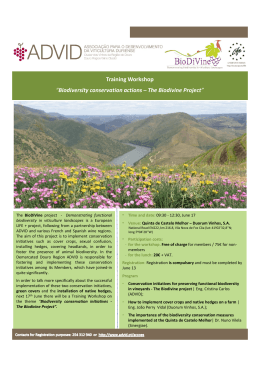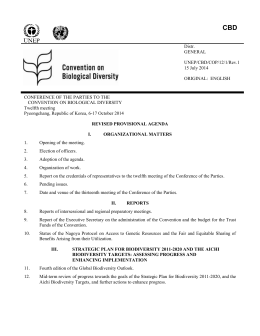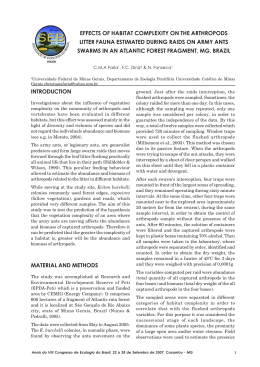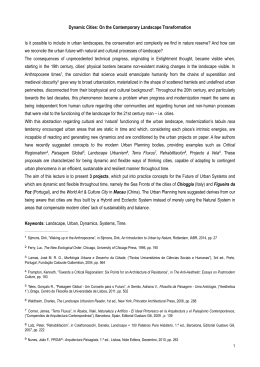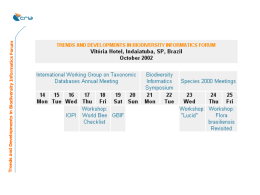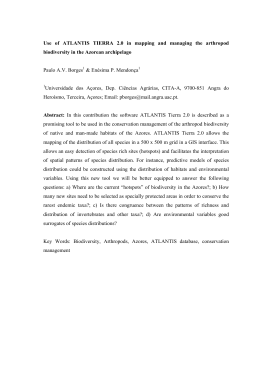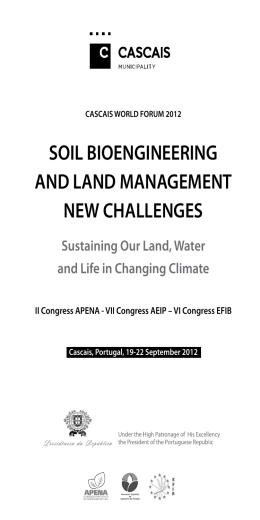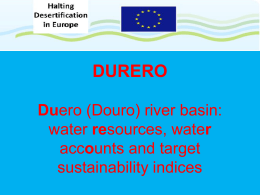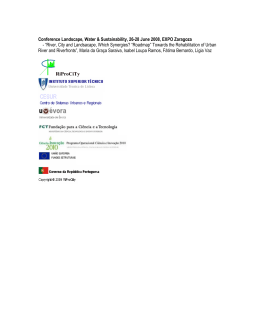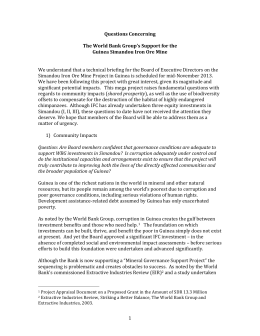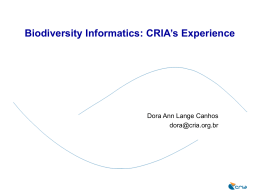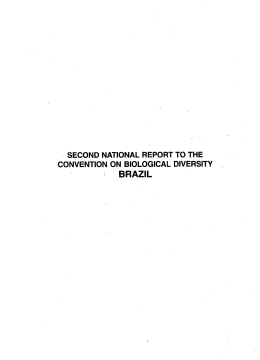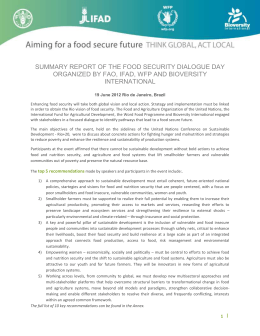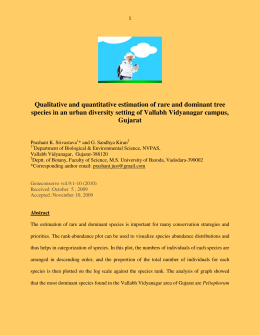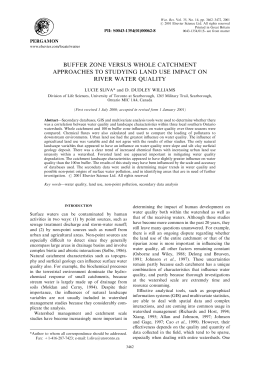Monitoring arthropod diversity in Douro wine region vineyards Alexis Rataux1, Cristina Carlos1, Fátima Gonçalves2, José Aranha2, Josépha Guenser3, Fernando Alves1, Maarten Van Helden4 ADVID – Association for the Development of Viticulture in the Douro, Quinta de Santa Maria, Apt. 137, 5050 -106 Godim, Portugal, [email protected] 2 CITAB – Centre for the Research and Technology of Agro-Environmental and Biological Sciences, University of Trás-os-Montes and Alto Douro, 5001-801, Vila Real, Portugal 3 Vitinnov, 1 Cours Général de Gaulle 33170 Gradignan, France 4 Bordeaux Sciences Agro, Université de Bordeaux, ISVV, 1 Cours Général de Gaulle 33170 Gradignan, France. [email protected] 1 Abstract: Nowadays, many actions aim to enhance the biological control in agro ecosystems in order to improve their resilience and sustainability. To what extent does the landscape structure improve biodiversity? Is it possible to adapt vineyard management or surrounding landscape to improve the presence of ecological infrastructures and thus increase biodiversity? Those two questions are the basis of the European project LIFE+ “BioDiVine: Demonstrating functional biodiversity in viticulture landscapes”. In Portugal, ADVID is in charge of the implementation of conservation actions and for monitoring their impact in three experimental sites located in the Douro Valley, with a global surface of nearly 500 hectares. In 2011, two types of traps (combi and pitfall) have been set up in five main habitats: vineyard, scrubland, urban, olive groves and olive hedgerows. The arthropods caught during seven weeks of assessment (April-June) were sorted out using the Rapid Biodiversity Assessment (RBA) method. Biological indexes were calculated and correlated with landscape characteristics (Shannon’s landscape index) calculated through a GIS database to investigate the way habitats influence arthropods’ biodiversity and, in the particular functional biodiversity (Coccinellidae and Staphylinidae, Araneae and Opilionidae). More than 52000 arthropods were counted and 789 morphospecies identified, belonging to 18 orders of Insecta and five orders of Arachnida. Arthropods caught by combi traps were more abundant on scrublands. Some positive correlations have been established between landscape components and arthropods presence. Staphylinidae abundance and richness were higher in more diverse landscape. Concerning other taxa, each order appears to be differently influenced by the landscape’s structure. Key words: Viticulture, functional biodiversity, landscape management Introduction Ecological resilience, pests' control and prevention of invasions are much influenced by the species' richness and genetic variability (OBRIST & DUELLI, 2010), in other words, by biodiversity. The declaration of 2010 as "year of biodiversity" by the UNO and UNESCO, the increase of pests' resistance problems and public demand of residue-free products have increased the interest for environmentally safe pest management and for conservation biological control. Therefore, researchers and growers are concerned in understanding how they could improve the presence of natural enemies in cultivated landscapes, by bringing more biodiversity into the cultivated surfaces. Such a dynamic needs to be supported by research work, which will allow them to estimate in situ if conservation actions have to be taken and which ones. The present results were extracted from the first study year of the arthropod biodiversity estimation in the Alto Douro Region's vineyard, situated in the north of Portugal. This is part of a European project called "BioDiVine", including three European countries (France, Portugal and Spain), and which will last four years (2011-2014). This international cooperation aims to evaluate the impact of the landscape's structure on functional biodiversity. Material and Methods The experiments were carried out in three pilot farms located in the Alto Douro Vinhateiro region. First of all, five categories of habitats were defined, namely vineyards, olive groves, olive tree alignment (OTA), urban sites and scrubland. Each one accommodated five trapping site's repetitions. A GIS database (ArcMap) was used to digitize land use and characterize the surrounding of each of the 25 trapping sites, for several buffer sizes (from 50 to 200m) using aerial photographs. The trapping system consisted of a combination of two traps, a "Combi trap", which aims to catch flying arthropods, and a "Pitfall trap", which aims to catch soil arthropods. Each trap was filled with a mix of water, salt (5%) and soap, and checked once a week. The harvest time ran over 12 weeks, from April to July, synchronized with the main the arthropods' development period. Because of the huge arthropods’ abundance observed during 2011, only the first seven weeks of the biological material collected was observed and classified using the Rapid Biodiversity Assessment (RBA) method. Moreover, we focused on four groups of easily identifiable beneficials (Araneae, Coccinellidae Opilionidae and Staphylinidae) as an indicator for functional biodiversity. Some indexes were calculated such as the Shannon-Weaver Index for biodiversity and for landscape. Finally, GIS and RBA data were crossed to try to show some tendencies in the way the landscape influences the arthropod biodiversity. Concerning the statistical analysis, one-way ANOVA followed by Fisher’s LSD honestly significant difference (HSD) test (p < 0.05) were used to compare the means obtained among different habitats, even if we didn’t realize any ECOSIM correction. When necessary, and in order to perform the assumptions of ANOVA, percentage data were arcsine square-root transformed, while the number of individuals captured (x) were transformed into a logarithmic scale log10 (x). If the assumptions of homogeneity of variances and normality were violated, a nonparametric Kruskal-Wallis test followed by the multiple comparison mean ranks by Fisher’s LSD as described on MAROCO (2007) was performed. Results and Discussion Landscape’s characterization The landscape’s digitalization allowed us to calculate the land use repartition as well as the “non used territory” (interstitial space) level. Main results are presented in Table 1. Concerning the interstitial space (e.g. road sides, ditches), which could potentially be manage as refuge spaces (ecological compensation areas) for promoting biodiversity, it represented approximately 2% of the space digitalized, which is to compare to the 5% level recommended by the OILB. Arthropods More than 52 000 individuals were caught, split into 24 arthropod Orders and 789 morphospecies (MS). The Combi trap results represented nearly 90% of the total abundance. Four main orders of insects were present: Coleoptera that represented nearly half of the global abundance (46, 3%), followed by Diptera (20, 1%), Hymenoptera (15, 2%) and Hemiptera (12, 6%). Concerning other arthropods, spiders represented up to 3% of the global abundance (Fig. 1 A). Concerning the arthropods’ global richness, Coleoptera and Hympenoptera were the most important orders, with respectively 25% and 22% of the total number of morphospecies (Fig. 1 B). Table 1- Global characterization of the landscape inside the buffers by GIS Buffer’s radius (m) Global surface (ha) Interstitial space (ha) Interstitial space (%) Shannon-Weaver Index for landscape 50 0,59 0,01 2% 0,64 100 2,36 0,04 2% 0,87 150 5,32 0,09 2% 0,97 200 9,47 0,15 2% 1,01 6,66 1,58 15,53 1,81 0,30 2,62 23,80 6,97 39,13 6,48 1,21 10,42 1,36 2,01 2,07 25,85 4,90 44,03 6,35 1,09 8,15 1,06 3,33 1,74 24,87 2,70 49,07 5,88 0,95 6,38 0,96 4,61 1,44 23,13 1,92 53,19 Habitats (%): Dirt roads OTA Olive groves Riparian forest River Sealed roads Scrubland Urban sites Vineyards Fig. 1 A Fig. 1 B Figure 1: Distribution among arthropod orders for total abundance (A) and morphospecies richness (B) Arthropods and landscape If we focus on the Combi trap results (main part of the caught individuals), significant differences appear between habitats. The scrubland and urban sites seem to show a higher overall abundance (Fig. 2). For arthropods’ richness, the statistical tests did not show any significant differences (α= 17,5 > 5%). Order distributions were different among habitats for both Combi- and Pitfall traps (Fig. 3 A and 3 B). Figure 2: Habitat’s influence over the arthropods abundance in the Combi traps. Fig. 3 A Fig. 3 B Figure 3: Order proportions according to the global abundance of each habitat in the Combi- (A) and Pitfall traps (B). These are the first results of the BioDiVine project concerning biodiversity’s comprehension and management. Data analysis is ongoing and more details will be presented in future publications. Acknowledgements The authors would like to thanks to Pedro Ferreira and Marco Magalhães for technical support in GIS work. References MAROCO, J. (2007). Análise estatística – Com utilização do SPSS. 3ªedição. Edições Silabo Lda, 822 pp. OBRIST, M.K. & DUELLI, P. (2010). Rapid biodiversity assessment of arthropods for monitoring average local species richness and related ecosystem services. Biodivers Conserv 19:2201-2220.
Download
